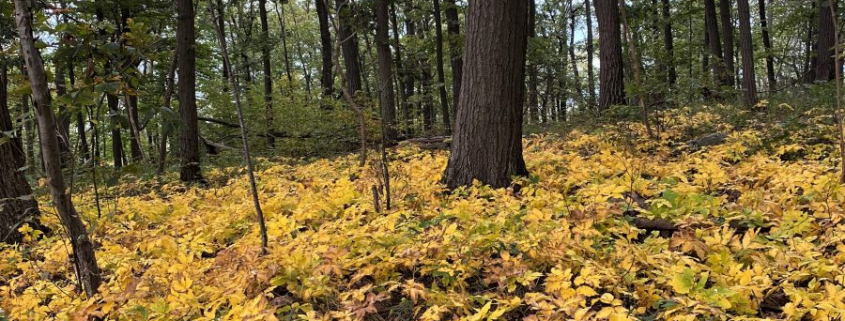September 2020 Rocky Gap State Park: Central Appalachian Fall Flowers, Ferns, and Fungi
September 26, 2020, I hiked the Rocky Gap State Park (ten miles east of my boyhood home in Cumberland, Maryland) Summit Trail, trekking from Lake Habeeb (1,150 feet elevation) to the summit of Evitts Mountain (2,296 feet) and return. See my earlier Post highlighting the forests and tree species I encountered and reflecting upon the Nature of the place that shaped and molded the man I am today: https://stevejonesgbh.com/2020/10/15/a-tough-hike-and-deep-reward-at-rocky-gap-state-park-in-western-maryland/
Early Fall Flowers
I developed this second Post from that strenuous six-hour hike in forests and terrain intimately familiar from five decades ago, and still-teaming with vivid memories and life-shaping experiences. I am and always will be a creature of place…place defined by forests, topography, seasonal flowers, understory perennial vegetation, fungi, and ferns. Consider this second Rocky Gap Post as a trip down Flora, Fungi, and Fern Lane.
Smartweed (Persicaria sp) is a non-showy genus that I’ve found everywhere I’ve resided, up and down the eastern edge of the US, including in Ohio, whose residents resent and find offense (I learned first-hand) at being referred to as “in the east.” They extended no forgiveness of my grave error even though I had just lived four years in far away Alaska. A matter of principal and pride I presume. Okay, I return from that “lesson learned” to Persicaria. Often, Wikipedia offers succinct plant summaries that are hard to resist employing in my Posts: Persicaria is a genus of herbaceous flowering plants in the knotweed family, Polygonaceae. Plants of the genus are known commonly as knotweeds or smartweeds. It has a cosmopolitan distribution, with species occurring nearly worldwide.
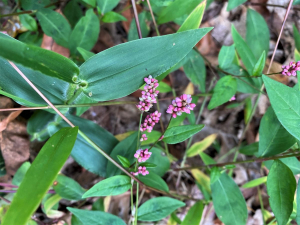
Mile-a-minute vine (Persicaria perfoliata) is a cousin to smartweed, sharing the same genus. I should have expected other than good news when I saw that another name for this plant (a plant I could not recall previously seeing) is mile-a-minute weed! From the Center for Invasive Species and Ecosystem Health: Persicaria perfoliata is an herbaceous, annual vine that invades disturbed areas in Oregon and portions of the northeastern United States. The delicate stems are reddish, highly branched and covered with small, curved spines. Circular, leafy structures surround the stem at the base of the petioles. The alternate leaves are triangular, light green, 1-3 in. (2.5-7.6 cm) wide and barbed on the undersurface. Small, white, inconspicuous flowers. Fruit are present in mid-July through the first frost, are metallic blue and segmented with each segment containing a single black or reddish black seed. Persicaria perfoliata invades open disturbed areas such as fields, forest edges, roadsides, ditches and stream banks. Its rapid growth allows it to cover existing vegetation and restrict light availability, potentially killing plants below. Dense mats of Persicaria perfoliata can also restrict establishment of new vegetation. It is native to Eastern Asia and the Philippines and was introduced several times into the United States from the late 1800s to the 1930s. Perhaps I should have pulled the few individuals I encountered!

Neither did I remember prior interactions with bluestem goldenrod (Solidago caesia). Once again, Wikipedia offered the best (and briefest) plant-bio: Solidago caesia, commonly named blue-stemmed goldenrod, wreath goldenrod, or woodland goldenrod, is a flowering plant native to North America. Whew, it is native! Its range extends from New England to the southern Appalachians. I noticed only two individuals of bluestem goldenrod.
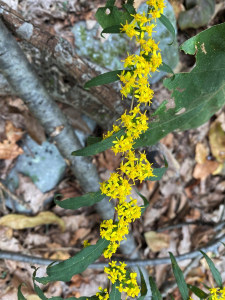
White snakeroot (Ageratina altissima) proliferated along my entire route from lake to summit. I found a delightful online information source, Brooklyn Botanic Garden (declaring white snakeroot the October 2016 Weed of the Month):
Fall-blooming white snakeroot is that nondescript weed that has been inconspicuously growing in shady spots all spring and summer. You barely notice the one- to four-foot-tall plant with toothy, dark green leaves until suddenly—poof! It’s everywhere you turn, all abloom with fluffy white flowers. One of the last wild natives to flower, Ageratina altissima is a godsend to hungry insects like bees, moths, and flies furiously foraging before the weather turns cold and food becomes scarce.
After blooming, its seeds are dispersed primarily by wind, their fuzzy tails carrying them far and wide. The plant also spreads by rhizomes (underground stems), so you’re as likely to see a colony as a single specimen. Originally a woodland plant, white snakeroot is also perfectly at home in the sidewalks, vacant lots, and shady gardens of Brooklyn. Such a shame, in the context of my hike, to term this showy late summer bloomer a weed!
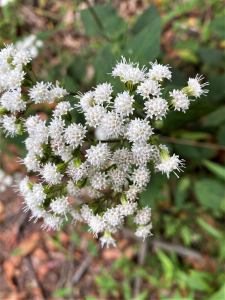
The meadow ground cover under the power line atop Evitts offered two exquisite early fall bloomers. Autumn hawkbit (Scorzoneroides autumnalis) is yet another alien species. From Spotwild online: Hawkbit is a perennial plant species, widespread in its native range in Eurasia (from Europe east to western Siberia), and introduced in North America. The plant is sometimes called fall dandelion, because it is very similar to the common dandelion (one of the main differences being a branched stem with several capitula), but “yellow fields,” covered by this plant appear much later than dandelion’s, towards the autumn in Eastern Europe. Fortunately, unlike the mile-a-minute weed, this introduced species is not aggressive in wildland environments. I appreciated its brightness and embraced its beauty.
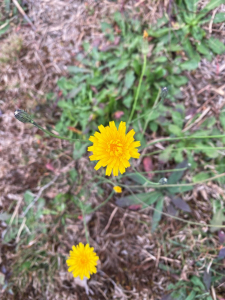
Common toadflax (Linaria vulgaris), also known as butter and eggs and wild snapdragon, seemed so perfectly at home atop Evitts, a just reward for my efforts to summit. However, Wikipedia notes that Linaria vulgaris is a species of toadflax, native from Europe to Siberia and Central Asia. It has also been introduced and is now common in North America. The Montana Department of Agriculture devoted a brief video identifying this introduced species as an invasive noxious weed, aggressively populating grazing lands. I’ll stand by yellow toadflax as a welcome wildland immigrant to the central Appalachians. Perhaps I am bewitched by its early fall magnificence. I suppose one man’s trash (a Montana cattleman) is another man’s treasure (this old forester and lifelong Nature enthusiast).
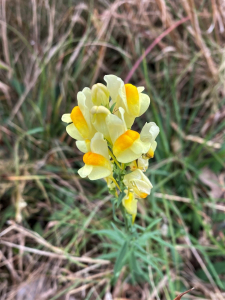
I remain a bit uncertain as to what constitutes and rationalizes the terms native, invasive, noxious, introduced, etc. Think about the first images of Earth transmitted back to us from the earliest Apollo missions. Carl Sagan described our planet as a pale blue orb, a mote of dust in the vast darkness of space. All of the non-native plants I identified above are native to this pale blue orb. Consider the context John Muir offered 105 years ago in Travels in Alaska:
When we contemplate the whole globe as one great dewdrop, striped and dotted with continents and islands, flying through space with other stars all singing and shining together as one, the whole universe appears as an infinite storm of beauty.
We humans, whether we choose to deny or accept it, are native as well. We are not separate from Nature. We are a species widely naturalized across six continents. As a matter of our global (natural) wanderings by land, air, and sea, we are distributing (intentionally or accidentally) species once restricted to distant corners of the planet. Is this dissemination somehow not natural simply because it is we humans who spread the seed? Whether Covid-19, kudzu, mile-a-minute weed, Dutch elm disease, chestnut blight, the European rat, or smallpox, geographically isolated species are now globally distributed.
Other Ground-Level Vegetation
I have loved spotted wintergreen (Chimaphila maculata; please don’t tell me that it, too, is an invasive!) since first seeing it many years ago. Its year-round foliage, bi-color brilliance, and deep green are resplendent. Wikipedia: Chimaphila maculata is a small, perennial, evergreen herb native to eastern North America and Central America, from southern Quebec west to Illinois, and south to Florida and Panama.
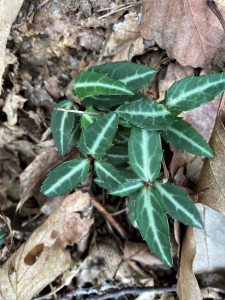
And what a pleasant surprise to find a yellow-carpeted grove along the trail. Well-named, goldenseal (Hydrastis canadensis) stood in solitary occupation of the understory, effectively claiming sole rights to early fall’s woodland hue. Goldenseal, also called orangeroot or yellow puccoon, is a perennial herb in the buttercup family Ranunculaceae, native to southeastern Canada and the eastern United States. It may be distinguished by its thick, yellow knotted rootstock (Wikipedia). Like so many of our native plants, goldenseal has medicinal uses. From Mount Sinai online:
Goldenseal (Hydrastis canadensis) is one of the most popular herbs in the United States, often combined with echinacea and sold to treat or prevent colds. But there is no evidence that it works. In fact, there is very little scientific evidence that goldenseal works to treat any condition. Nevertheless, goldenseal is often said to kill bacteria and is sometimes used to treat eye infections, diarrhea, urinary tract infections, canker sores, and vaginitis. A substance in goldenseal, called berberine, does kill some kinds of bacteria and fungus in test tube studies. But scientists do not know if goldenseal would kill any germs in people. Goldenseal is also popular because of a rumor that taking the herb can help block a positive test for illegal drugs. There is no evidence that it works, and several studies have reported that taking goldenseal does not change the results of a drug test.
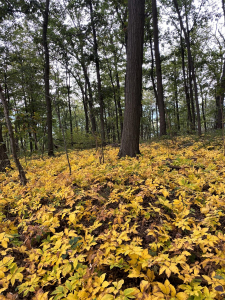
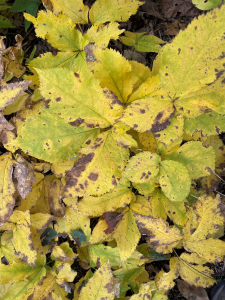
As with all of my Nature-Inspired Life and Living Posts, I am simply hitting the highlights of what I noticed along the way. With the toadflax and goldenseal in particular, I wanted sit within the yellow or rest beside the toadflax lost in the moment… for hours on end. Absorb the beauty, magic, wonder, and awe via direct and prolonged contact.
Robert Frost nailed my sentiment and desire in Stopping by Woods on a Snowy Evening:
Whose woods these are I think I know.
His house is in the village though;
He will not see me stopping here
To watch his woods fill up with snow.
My little horse must think it queer
To stop without a farmhouse near
Between the woods and frozen lake
The darkest evening of the year.
He gives his harness bells a shake
To ask if there is some mistake.
The only other sound’s the sweep
Of easy wind and downy flake.
The woods are lovely, dark and deep,
But I have promises to keep,
And miles to go before I sleep,
And miles to go before I sleep
A dinner with extended family back in Cumberland hurried me along, leaving the protracted woods-immersion for another day.
Fungi and Ferns
John Muir also known as “John of the Mountains” and “Father of the National Parks,” was an influential Scottish-American naturalist, author, environmental philosopher, botanist, zoologist, glaciologist, and early advocate for the preservation of wilderness in the United States of America (Wikipedia).
Just when I think I’ve offered an original thought on our place in Nature, I find that historical stalwarts like John Muir reached the same conclusion, often many years before I entered the world. Because my wildness wanderings today seek subtleties in Nature’s forms, functions, diversity, relationships, and even ironies, I have drifted far from my early career focus on commercially valuable merchantable trees. After all, I worked then for a forest products company… and fortunately, a firm with a strong land stewardship ethic, both professed and practiced. Now proceeding through my 70th year, I am paying more and more attention to not just flowers, but also to ferns and fungi… what Muir considered among the commonest of natural phenomena:
The natural and common is more truly marvelous and mysterious than the so-called supernatural. Indeed most of the miracles we hear of are infinitely less wonderful than the commonest of natural phenomena, when fairly seen (My First Summer in the Sierra; John Muir 1911).
Although I stayed on the trail for most of my journey, I stayed alert for the marvelous and mysterious ferns and mushrooms within the adjacent forest.
Fungi
I’m learning more about mushrooms and the specific fungal organisms (now meriting their own fungi life Kingdom, along with Animals and Plants!) they represent. Earthball (Scleroderma sp.) struck me as other-worldly… scaly, patterned, with a peephole into a dark interior. I am uncertain about the species. Several references suggest a global distribution of members of this genus. The Fungus Fact Friday website refers to Scleroderma citrinum as a common earthball that appears in a variety of habitats around the world. The mushroom is one of the most often collected Scleroderma species, so one of its common names (mostly used in Europe) is “The Common Earthball.” S. citrinum has a couple other common names: “The Pigskin Poison Puffball” and the less common “Golden Scleroderma.” Both of these names refer to the mushroom’s outer surface, which is yellow-brown and has a scaly texture reminiscent of a football (American style, often called a “pigskin”). The mushroom’s thick warty outer skin makes it stand out among other earthballs and its interior that quickly turns blackish easily separates it from the true puffballs. I’ll stick with the generic earthball moniker.
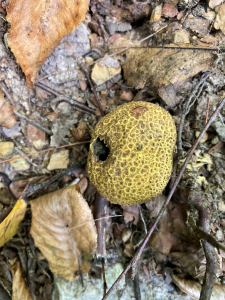
I found a single clump of what iNaturalist identified as honey mushroom (Armillaria sp). Armillaria, is a genus of fungi that includes the A. mellea species known as honey fungi that live on trees and woody shrubs. It includes about 10 species formerly categorized summarily as A. mellea. Armillarias are long-lived and form some of the largest living organisms in the world (Wikipedia). I won’t attempt to narrow the identification to species. The internet is rich with information, both helpful and discouraging. Online videos with titles such as These honey mushrooms have three poisonous look-alikes, served as a signal of caution. I am comfortable for now to stick with honey mushroom.
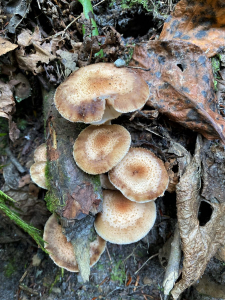
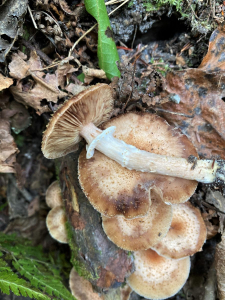
I discovered only one patch of hedgehog mushrooms (Hydnum sp). I believe the species below is Hydnum subolympicum (eastern North America’s hardwood-associated Hydnum species (MushroomExpert.com), very similar to the European Hydnum repandum, which is commonly known as the sweet tooth, wood hedgehog or hedgehog mushroom, is a basidiomycete fungus of the family Hydnaceae. First described by Carl Linnaeus in 1753, it is the type species of the genus Hydnum (Wikipedia). MushroomExpert.com website notes: By current, DNA-informed definitions Hydnum repandum does not occur in North America, although the name has traditionally been used in North American field guides. Here’s a relevant source quote from the west coast pertaining to Hydnum sp: Mushrooms with teeth? As a matter of fact, yes. Nothing intimidating, mind you, but these mushrooms do have small toothlike projections rather than gills on their lower cap surfaces. The tooth fungi, also known as “hedgehog” and “sweet tooth,” appears in a variety of forms. Some grow as shelves on trees. Most are found on the ground. Colorful ones decorate the forest floor with their white, buff, red, orange-brown, blue, and purple caps. Several of the brightly colored wood varieties are used for dyeing woolen yarns (Mycological Society of San Francisco). See the distinctive underside teeth below right. Although I did not harvest this sample, most references describe Hydnum species as edible. I will consider this possibility when I find a suitable colony here in Alabama.
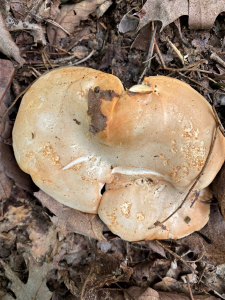
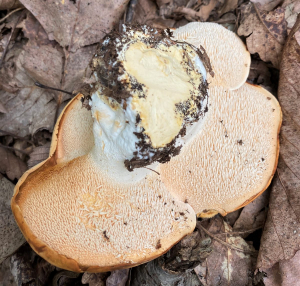
I had seen coral tooth fungus (Hericium sp) in my local woods ramblings. I found this specimen (below) growing at the well-decayed base of a downed tree stem, just as the following paragraph from ForagerChef.com described: These like to come up in the late fall in the Midwest, when the leaves start to drop from the trees, but they’re choosy as to where they grow, and to me it seems like each mushroom eating the decomposing tree can have their own internal clock when it decides to fruit, similar to chicken of the woods, although this could easily be due to difference in the host tree species, I’m speculating a bit here. I do know for sure that to find them you need to be in a place that has decomposing wood, not just old fallen trees, fallen trees that are well on their way to the next world, those sinking into the ground, and often in my spots, covered with moss. I spotted this one several hundred feet ahead as I ascended Evitts. About five feet from the trail, its bright white stood like a banner backed by the near-black host log. I admit to harvesting, sautéing, and dressing a hamburger later that evening. Nice texture and mild flavor…a perfect accent to a grilled burger. I ask readers to recognize that you identify, harvest, prepare, and consume any foraged mushroom at your own risk. Do not take my word as gospel; do your own research.
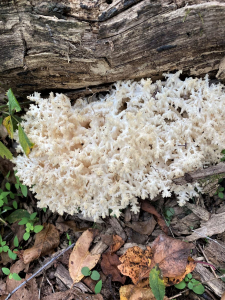
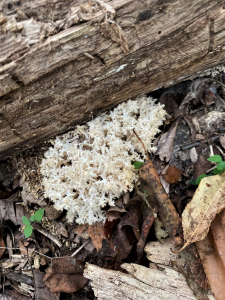
Ferns
Everywhere I’ve lived common bracken fern (Pteridium aquilinum) appears abundantly, from coastal Georgia to interior New England to Pennsylvania to western Ohio to Alaska. Bracken is a genus of large, coarse ferns in the family Dennstaedtiaceae. Ferns are vascular plants that have alternating generations, large plants that produce spores and small plants that produce sex cells. Brackens are noted for their large, highly divided leaves (Wikipedia). Hay-scented fern (Dennstaedtia punctilobula) is widely distributed across the eastern US. The eastern hay-scented fern or hay-scented fern, is a species of fern native to eastern North America, from Newfoundland west to Wisconsin and Arkansas, and south in the Appalachian Mountains to northern Alabama (Wikipedia). Both species ranged abundantly across my doctoral research field study plots in SW New York and NW Pennsylvania within the Allegheny Hardwood forest type. I recall thick patches thigh-high of one species or the other as I paced from one sample point to another.
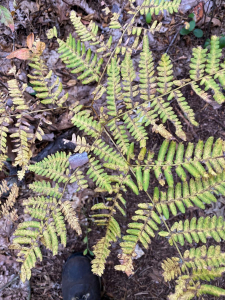
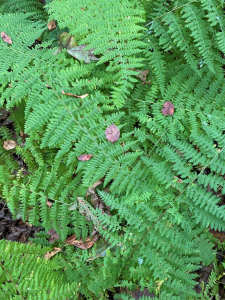
My examinations of Rocky Gap’s fall flowers, ground vegetation, fungi, and ferns triggered deep memories. The six-hour hike took me back 50 years to a place I still call home. Nature does that to me… lifting me, sculpting me, and reassuring me that all is well whether at age 20 or now at 69. Nature is an elixir for Life and Live. Nature blesses all who observe and enjoy her wonders with her infinite storm of beauty!
Thoughts and Reflections
I offer three observations from my floral, fern, and fungi hike in the central Appalachians:
- Nature creates deep memories and later spurs meaningful recollections
- Any walk in wildness stimulates mind, body, heart, soul, and spirit
- Nature does indeed appear as an infinite storm of beauty
-
Inhale and absorb Nature’s elixir. May Nature Inspire, Inform, and Reward you!
Note: All blog post images created & photographed by Stephen B. Jones unless otherwise noted. Please circulate images with photo credit: “©2020 Steve Jones, Great Blue Heron LLC. All Rights Reserved.”
Another Note: If you came to this post via a Facebook posting or by an another route, please sign up now (no cost… no obligation) to receive my Blog Post email alerts: http://eepurl.com/cKLJdL
And a Third: I am available for Nature-Inspired Speaking, Writing, and Consulting — contact me at steve.jones.0524@gmail.com
Reminder of my Personal and Professional Purpose, Passion, and Cause
If only more of us viewed our precious environment through the filters I employ. If only my mission and vision could be multiplied untold orders of magnitude:
Mission: Employ writing and speaking to educate, inspire, and enable readers and listeners to understand, appreciate, and enjoy Nature… and accept and practice Earth Stewardship.
Vision:
- People of all ages will pay greater attention to and engage more regularly with Nature… and will accept and practice informed and responsible Earth Stewardship.
- They will see their relationship to our natural world with new eyes… and will understand more clearly their Earth home.
Tagline/Motto: Steve (Great Blue Heron) encourages and seeks a better tomorrow through Nature-Inspired Living!
Steve’s Three Books
I wrote my books Nature Based Leadership (2016), Nature-Inspired Learning and Leading (2017), and Weaned Seals and Snowy Summits: Stories of Passion for Place and Everyday Nature (2019; co-authored with Dr. Jennifer Wilhoit) to encourage all citizens to recognize and appreciate that every lesson for living, learning, serving, and leading is either written indelibly in or is powerfully inspired by Nature.
I began writing books and Posts for several reasons:
- I love hiking and exploring in Nature
- I see images I want to (and do) capture with my trusty iPhone camera
- I enjoy explaining those images — an educator at heart
- I don’t play golf!
- I actually do love writing — it’s the hobby I never needed when my career consumed me
- Judy suggested my writing is in large measure my legacy to our two kids, our five grand kids, and all the unborn generations beyond
- And finally, perhaps my books and Blogs could reach beyond family and touch a few other lives… sow some seeds for the future


All three of my books (Nature Based Leadership; Nature-Inspired Learning and Leading; Weaned Seals and Snowy Summits) present compilations of personal experiences expressing my (and co-author Dr. Wilhoit for Weaned Seals and Snowy Summits) deep passion for Nature. All three books offer observations and reflections on my relationship to the natural world… and the broader implications for society. Order any and all from your local indie bookstore, or find them on IndieBound or other online sources such as Amazon and LifeRich.

